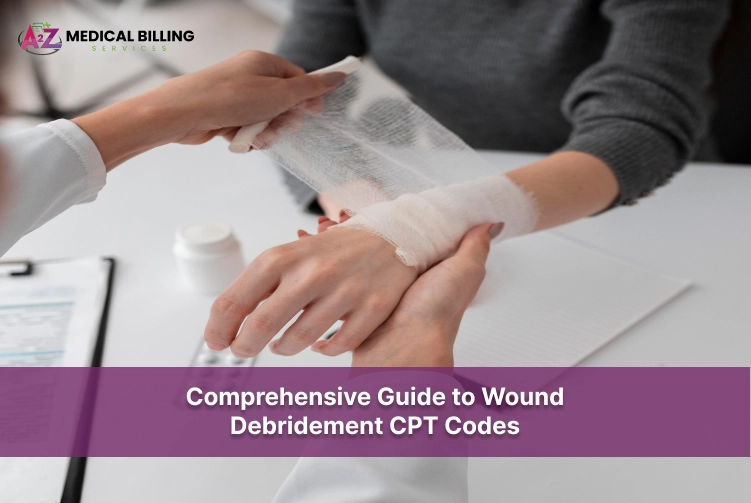Wound debridement is critical in managing chronic and acute wounds, facilitating faster healing by removing non-viable tissues. CPT codes for wound debridement vary based on the depth of tissue removed and the techniques used.
The debridement CPT codes reflect specific types of selective, non-selective, or autolytic, affecting how procedures are billed and reimbursed. Knowing these details helps avoid common coding errors which can lead to claim denials.
Today, we will break down the most commonly used procedure codes for wound care debridement, and their applications, and provide medical notes tips to ensure compliance with medical coding standards.
Deep Understanding of Wound Debridement CPT Codes
Understanding the accurate wound debridement procedure codes are essential for compliant medical billing and documentation in healthcare.
More About Wound Debridement
Wound debridement involves the removal of necrotic tissue, waste, and toxins from a wound to promote healing. This debridement procedure is critical for managing various types of wounds, ensuring they heal properly without infection or complications.
Types of Wound Care Debridement
- Autolytic Debridement
- Enzymatic Debridement
- Mechanical Debridement
- Sharp or Surgical Debridement
- Biological Debridement
Key CPT Codes for Wound Debridement
Below section entail the primary CPT codes used for different types of wound debridement.
| CPT Code | Description | Application |
| 97597 | Selective debridement of skin and subcutaneous tissue up to 20 sq cm | Used for superficial wounds |
| 97602 | Non-selective debridement, including enzymatic application and simple cleansing of the wound. | Chronic wound with significant amount of necrotic tissue. |
| 97598 | Selective debridement of skin, each additional 20 sq cm | Used for larger superficial wounds |
| 11042 | Debridement of subcutaneous tissue (first 20 sq cm) | This applies to deeper tissue layers |
| 11045 | Debridement of subcutaneous tissue, each additional 20 sq cm | For extensive subcutaneous wounds |
| 11043 | Debridement, muscle, and or fascia (first 20 sq cm) | For deeper muscular layers |
| 11046 | Debridement, muscle, and or fascia, each additional 20 sq cm | For extensive muscular wounds |
| 11044 | Debridement, bone (includes lower layers, first 20 sq cm) | For deepest wounds, involving bone |
| 11047 | Debridement, bone, each additional 20 sq cm | For extensive bone involvement |
Common Modifiers Used with Wound Debridement Procedures
Modifiers play a critical role in wound debridement coding, adjusting the description of a service to ensure precise billing and reimbursement.
| Modifier | Description |
| 59 | Distinct procedural service: Indicates procedures not normally reported together, but are appropriate under the circumstances. |
| 51 | Multiple procedures: Used when more procedures are performed during the same surgical session. |
| 58 | Staged or related procedure or service by the same physician during the postoperative period. |
| 78 | Unplanned return to the operating/procedure room by the same physician following the initial procedure for a related procedure during the postoperative period. |
| 76 | Repeat procedure by the same physician: Used if a procedure is repeated on the same day. |
Specific Wound Debridement CPT Code
Focusing on the use of CPT codes and the necessary documentation to ensure accurate billing and coding.
CPT Code 97597 – Selective Debridement
CPT code 97597 is used for specific removal of non-living tissue and dead skin using tools such as scalpels, scissors, and forceps. This code is intended for wounds 20 square centimeters or smaller.
CPT Code 11042 – Subcutaneous Tissue Debridement
CPT code 11042 applies to the debridement of subcutaneous tissue, covering up to the first 20 square centimeters of a wound. This code is crucial for deeper layer debridement procedures that don’t reach muscle or bone.
Documentation and Compliance for Wound Debridement Coding
The critical importance of accurate medical documentation and adherence to CMS coding standards for wound debridement is critical to ensure compliance and proper practice revenue.
Best Practices for Clinical Documentation
The patient’s medical notes serve as a primary measure for wound debridement procedure. Important details include:
- Wound Assessment: Record the wound’s size, location, type, and severity before and after debridement.
- Procedure Details: Include the method of debridement (e.g., sharp, enzymatic), the extent of tissue removed, and the duration of the procedure.
- Rationale for Debridement: Justify the medical necessity of the debridement, linking it to the overall treatment plan.
- Outcome and Follow-up: Note any immediate outcomes of the procedure and specify any follow-up care plans as required.
Avoiding Common Coding Errors
To minimize errors in wound debridement billing, healthcare providers should focus on:
- Correct CPT Selection: Ensure the CPT codes reflect the depth of debridement performed. Misapplication of codes can lead to claim denials.
- Modifier Use: Apply proper modifiers to indicate when multiple procedures are performed during the same session or when services are unusual.
- Up-to-date Coding Standards: Stay informed about changes in coding standards and reimbursement policies to avoid outdated practices.
- Cross-checking and Verification: Verify documentation with coding specialists to catch and correct errors before claim processing.
Advanced Coding Scenarios for Debridements of Wound
Complex coding scenarios in wound debridement, providing insights into managing multiple wounds and recent updates in coding guidelines.
Managing Multiple Wounds
When treating multiple wounds, coding becomes more complex, but following structured guidelines can ensure its accuracy:
- Aggregate Size Coding: Sum the sizes of similar wounds to determine the correct CPT code, especially when treating wounds of the same depth.
- Multiple CPT Codes: Utilize separate CPT codes for wounds of different depths or significantly different types, ensuring it is recorded for specific treatment.
- Documentation Clarity: Provide clear, detailed descriptions of each wound and its specific treatment to support the use of multiple CPT codes.
Updates in CPT code for Debridement of Wound
Staying updated to date with debridement coding is crucial for compliance and proper reimbursement to medical clinics.
- Annual CPT Updates: Regularly review changes in the CPT codes related to wound debridement as updated by the AMA.
- Regulatory Guidance: Pay attention to new guidance from coding authorities and Medicare, especially concerning complex debridement cases.
- Continuing Education: Engage in ongoing education opportunities to keep ahead of best practices and changes in wound care coding.
Let’s Recap
Wound debridement CPT codes are essential for optimizing patient care and ensuring precise billing. Accurate coding is not just administrative but crucial for recognizing the medical necessity of treatments, reducing claim denials, and enhancing reimbursement.
Keeping current with coding updates, utilizing electronic health records (EHRs), and engaging in continuous education are vital for adapting to regulatory changes and improving data accuracy. As healthcare shifts towards value-based care, accurate coding for wound debridement becomes increasingly important, ensuring each step towards healing is documented and reimbursed appropriately.



